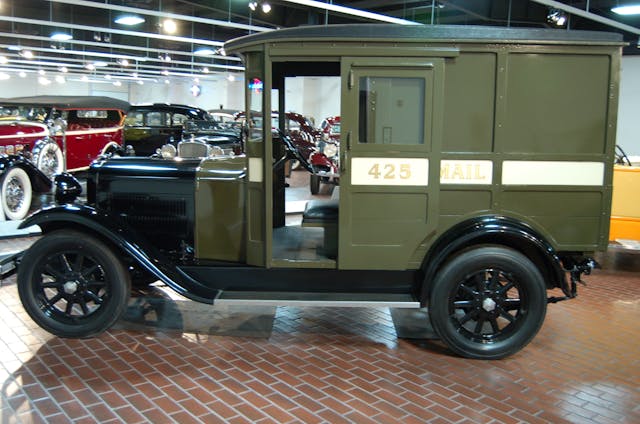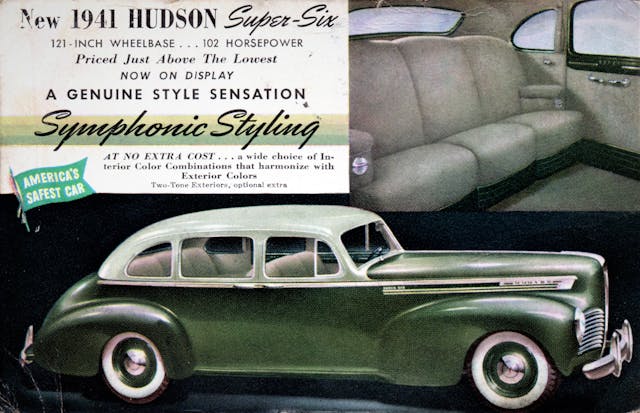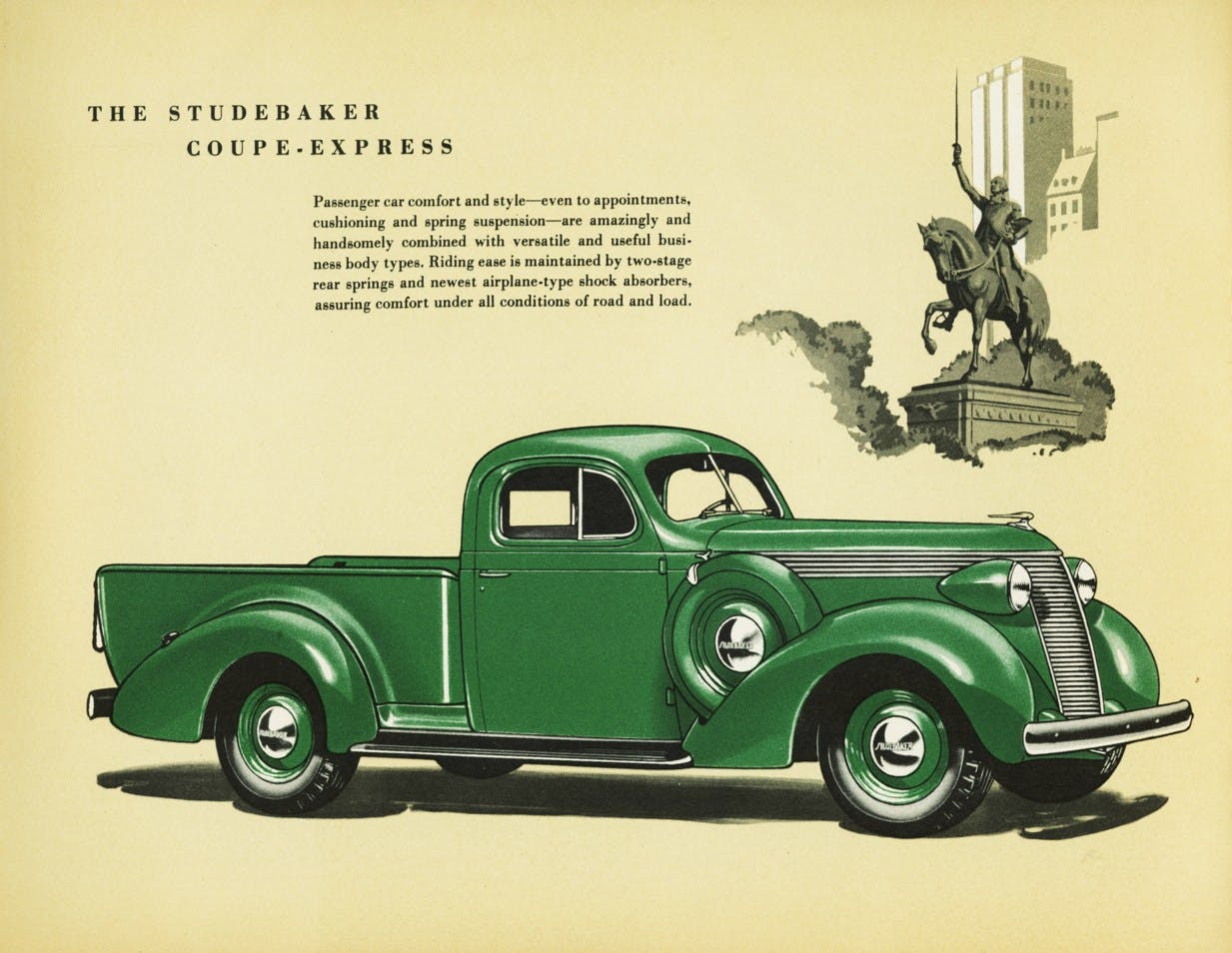Media | Articles
Did Ute Know? The first car-based pickup was not a Chevy
For a group that likes to call themselves car people, automotive enthusiasts have an odd affection for cars that look like trucks: The Chevrolet El Camino, the Ford Ranchero, and the Subaru Brat.
Whatever you call these oddities—car-truck, truck-car, cowboy Cadillac, ute—it’s tempting to say that they trace their lineage back to Henry Ford and the 1917 Model TT truck. Though early Ford cars and trucks are obviously related, the TT was a purpose-built utility vehicle with a more substantial frame and drivetrain. Typically, car-based trucks have gone in the other direction, borrowing their mechanicals from automobiles, not trucks, and tilting the utility/luxury balance more towards the latter.
So, if not the Model TT, which vehicle is the true founder of the car-truck line?

Since I haven’t done a Marianas Trench–level dive into the subject, I can’t say with 100 percent certainty that it was independent automakers Studebaker and Hudson that first introduced actual car-based pickup trucks to the American market. However, I believe that the 1937–39 Studebaker Coupe Express and the 1941–47 Hudson Cab Pick-up (including the 3/4 ton “Big Boy” models) are among the very first American vehicles that combined pickups’ cargo beds with the styling, sheetmetal, and mechanical componentry of those brands’ passenger cars.
Introduced for the 1937 model year, the Coupe Express was based on the Studebaker Dictator. In case you’re wondering why Studebaker would choose a model name associated with despots, the Dictator nameplate was introduced in 1927, before Hitler, Mussolini, Franco, and Stalin had solidified the word’s modern connotations. If the branding scheme is now awkward, it was at least coherent: Dictator was the entry-level Studebaker, below the midrange Commander and flagship President.

Marketplace
Buy and sell classics with confidence

Power was supplied by Studebaker’s larger, 218-cubic-inch (3.6 liter) L-head inline six-cylinder producing 86 horsepower, driving through a three-speed manual transmission, with an optional Borg-Warner overdrive available. Typical passenger-car options like radios, heaters, and turn signals were available. You could even choose from two different styles of steel wheels. (Yes, young Padawan, things like heaters and turn signals were not always standard equipment, let alone air conditioning. Before the 1976 Honda Accord, cars were very much priced à la carte.) About 3000 units of the introductory Coupe Express were sold. Advertising touted the “passenger-car comfort and style … combined with useful business body types.”
For the 1938 model year, the cab of the Coupe Express was updated to reflect styling changes on the passenger cars. In this case, styling alterations made the vehicle more practical: They allowed for a slightly longer cargo bed, which featured a sharp-looking, backwards-sloped tailgate. Despite the styling changes, sales dropped by almost two-thirds to around 1200 trucks. Again, the 1939 models were restyled to reflect Studebaker’s cars, but sales of the utes dropped even more, to just about 1000 units. The Coupe Express was discontinued to be replaced in 1941 by a 1/2 ton model of Studebaker’s more conventional M-Series pickup in 1941.
Hudson, on the other hand, never developed a dedicated truck line. You could well argue that all of Hudson’s pickup trucks, in fact all of its light commercial vehicles, were car-based. This wasn’t a bad thing, since Hudson’s automobiles were regarded as robustly overbuilt; perhaps they were suited well for the task of being car-truck hybrids.
In 1929 Hudson’s Dover truck brand started selling a line of commercial vehicles based on the parent company’s Essex automobiles, equipped with pickup beds, side-express bodies, or custom bodies made by the Hercules company in Kentucky. The United States Postal Service was a major customer, buying 500 of the car-based trucks, presumably for mail delivery. One of those postal utes, shown below, long resided at the Hostetler Hudson Museum in Shipshewana, Indiana, which closed in 2018.

Hudson also sold those same vehicles under the Essex brand, with slight changes. In 1932, a new line of pickups and sedan deliveries were offered, based on the Terraplane. With the Great Depression going on, sales were modest and peaked at about 8000 units in 1937.

That year, Hudson’s lineup of what it called Commercial Cars was expanded to also include a cab and chassis model, a sedan delivery, a station wagon, plus a “Utility Coupe,” which had a small pickup box that pulled out like a drawer from the trunk, and a “Utility Coach,” a two-door sedan with removable seats and panels to cover the rear quarter windows.
For the 1939 model year, the lineup was expanded yet further, offering three different wheelbases and multiple trim levels, all of them with car styling. That year the heavy-duty 3/4 ton Big Boy trucks were introduced. In 1940, when Hudson cars got new front-end styling and A-arm front suspensions with coil springs, the trucks shared those modern developments.
The Hudson trucks introduced in 1941 were probably the most car-like. Hemmings describes them as “low, long and dripping with chrome,” looking “like something dreamed up by a customizer… rather than the product of a mainstream American automaker.” Contemporary advertising focused on “new beauty and style,” plus “passenger car roominess and comfort.”

The fact that the ’41 Super-Six is considered by Hudson enthusiasts to be one of the marque’s most attractive products didn’t hurt. The half-ton Cab Pickup and the three-quarter-ton Big Boy models were based on 116- and 128-inch wheelbase versions of the Super-Six Commodore. Though those were midrange cars, they had substantial frames with 7 3/8″-inch tall rails and four lateral crossmembers augmented by a stiff X-member. The independent A-arm, coil-sprung front end was billed as “Auto-Poise Front Wheel Control,” the rear end had leaf springs with a track arm, and all four corners were dampened with modern hydraulic tube-type shock absorbers. The trucks did feature stiffer springs than the passenger cars and the Big Boy’s brakes 11-inch drums came from the parts shelf for the Hudson Eight.

The Hudson pickup may have been based on a sedan, but even the shorter-wheelbase model had a full-steel pickup bed measuring more than 48 inches between the inner fender walls and 93 inches front to back: With the tailgate down, you could carry a full sheet of plywood. On the inside, the dashboard offered the sedan’s clock, “Weather-Master” heater, Zenith radio, and deluxe steering wheel with a chrome horn ring as optional features. Super Six mechanicals were included as well, with Hudson’s 212-cubic-inch inline six driving through a column-shifted three-speed transmission that, like the Studebaker’s, was also available with an overdrive.
The war-shortened 1942 model year introduced Super Six sedan features such as slicker, restyled fenders and a flared lower body to hide the running boards. As with most cars in the immediate postwar period, the 1946 models were much like the prewar cars except for a new grille. The pickups, although they were some of the first postwar vehicles that Hudson made, still retained the earlier body style with exposed running boards—possibly due to their lower volume compared to the cars.
When Hudson introduced its innovative “Step-down” 1948 models, the firm stopped making pickup trucks as they were not compatible with the new model’s semi-unibody construction. While one prototype was reportedly developed, Hudson would never make another production pickup truck, car-based or otherwise, again. The company would merge with Nash to form American Motors in 1954.
Can we say with absolute certainty that Studebaker and Hudson made America’s first car-based pickups? No, but one thing’s for sure: Chevrolet and Ford were fashionably late to the party.
***
Check out the Hagerty Media homepage so you don’t miss a single story, or better yet, bookmark it. To get our best stories delivered right to your inbox, subscribe to our newsletters.
















The 1937 Hudson Terraplane was not mentioned! It was the best looking of all of them. How can you miss such an obvious front runner?
I thought the 1932 ford car base ute was first.
My grandfather had a Hudson Teroplane car/pickup that was awesome to look at… as I recall it featured a vacuum shift controller on the steering column! And I seem to remember that it was a 1938 model. He would often say…. Frank, if you keep them lubricated they will never wear out!
1936 Chevrolet Standard Series FC Coupe Pickup.
Chevrolet offered the Coupe Pickup for Depression-affected customers who wanted to save money by having a single vehicle that served as a personal car and a working truck. Long before the popular El Camino in 1959, Chevrolet sold an automobile-based truck by producing a small pickup bed which fit in the trunk of its popular five-window coupe model. Just 3,183 Coupe pickups were built by the factory and it is believed only 10 survive.
Two of the 10 are in Cartersville, GA; one at Savoy Automobile Museum, and the other is mine.
https://hidrive.com.au/a-brief-history-of-the-ute/#:~:text=In%201934%2C%20the%20first%20Ford,the%20'Aussie%20Kangaroo%20Chaser‘.
The first Utility (Australian for Pick Up) was designed in Australia in 1932 by Lew Bandt at the Ford Factory in Gellong, Victoria and put into production soon after.
The first “UTE” was built in Australia in 1934. A true “UTE” is one body, not a separate unattached bed at the back. It was built by Ford Australia.
https://www.abc.net.au/news/2022-02-27/great-australian-ute-story-of-utility-vehicle-s-birth/100855458
Another car body based truck was the 1947-54 Nash pickup, flatbed, and chassis/cab trucks, all based on the 1947 Nash 600 sedan front body shell with a pickup cab back panel welded onto the front section of the sedan body.
In 1948 the local Nash dealer in Littlestown, PA bought a new Nash tow truck, a very heavy-duty truck. About 35 years ago I found the truck in a local junkyard, but it was very rough, and so “buried” in the middle of the yard it would have required a helicopter to get it out.
These larger Nash trucks were built on a special truck chassis that was wider than the regular sedan. To cover the wider front wheel track, the front sedan fenders had to be cut apart and multiple sheet metal panels welded in place.
This article is referring to a coupe utility, a single bodied vehicle (think of a 1957 Ford Ranchero or a 1959 Chevrolet El Camino). These body styles were popular in Australia from the 1930’s. I have photos of a 1935 & 1936 Ford Convertible Coupe Utility and a 1934, 1936 & 1939 Ford Coupe Utility all that are right hand drive. I have photos of a 1951, 1952 and a 1956 Holden FX Coupe Utility all right hand drive. I have a photo of a 1947 Plymouth Coupe Utility (Model P15) right hand drive. I could not attach the photos here.
I tried to upload the same pics, the best I could do was post the web address where the pics can be seen.